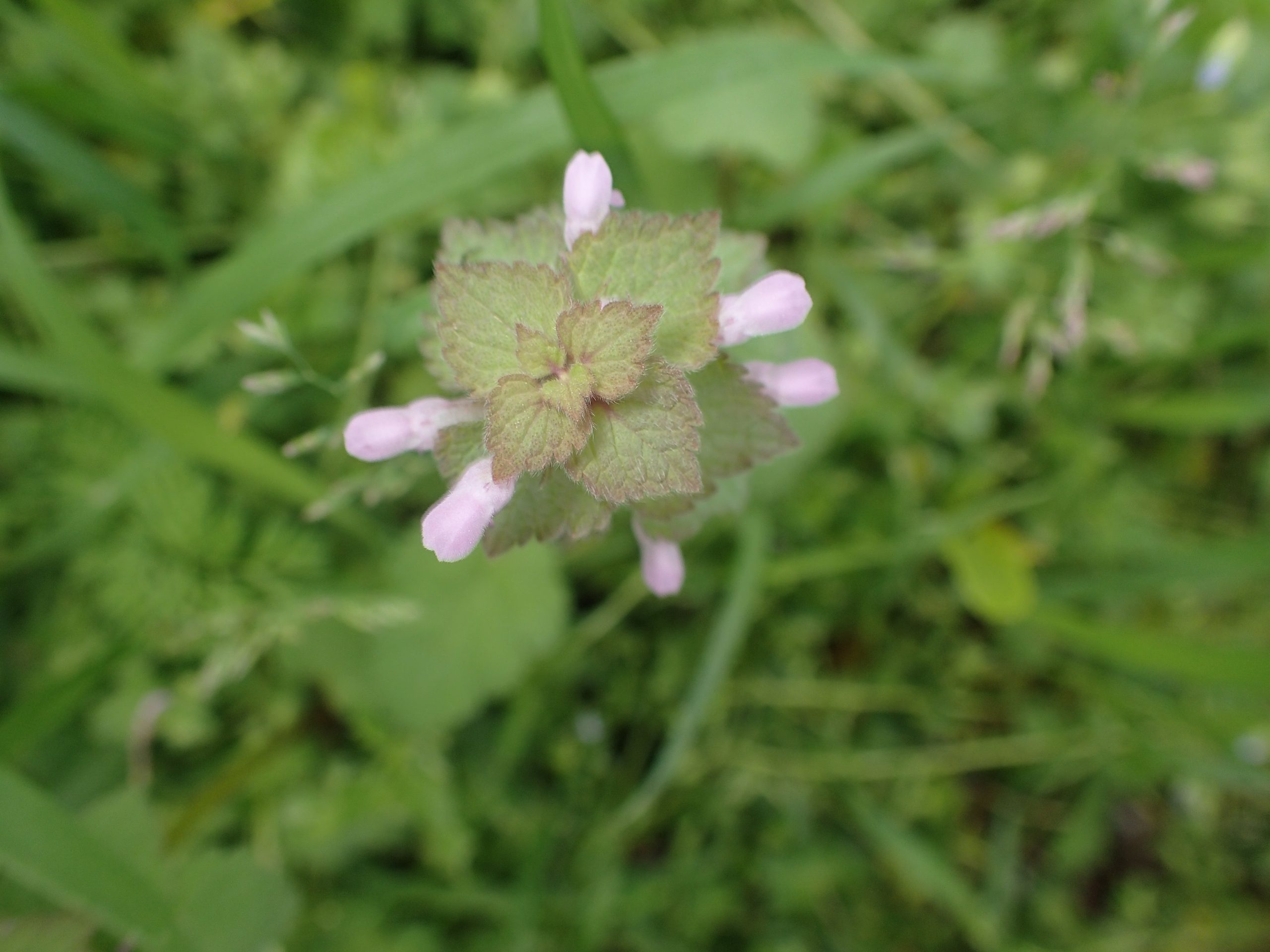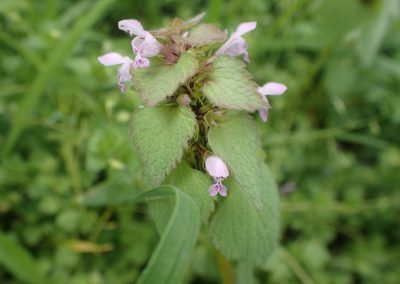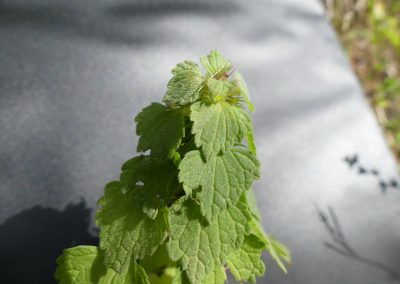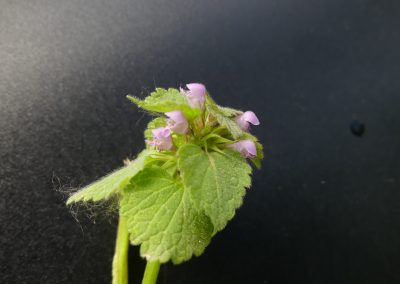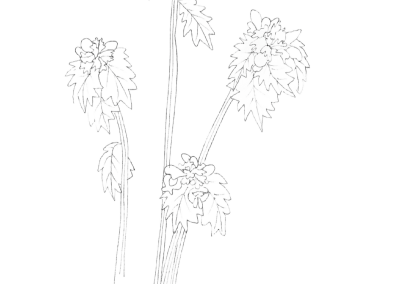Lamium purpureum
Scientific description
Taxon: Lamium purpureum
Class: Dicotyledons (Magnoliopsida)
Subclass: Asterids
Order: Lamiales
Family: Lamiaceae
Common name: Red dead-nettle / Purple dead-nettle
Origin:
Europe and Western Asia.
Description:
Small annual to biennial herbaceous plant (10–30 cm). Opposite, oval, toothed leaves, often purplish at the tips. Square stems (typical of Lamiaceae). Flowers from winter to spring, sometimes year-round; small, tubular, pink-purple, clustered in the axils of the upper leaves. Rapid colonizer of fields, wastelands, and roadsides. Often confused with other Lamium species, distinguished by its colored upper leaves.
Propagation:
By abundant seeds dispersed on the ground (autochory), rapid germination.
Ecology:
Ruderal, nitrophilous, pioneer of disturbed soils. Attracts early-season pollinators (bees, bumblebees).
Uses:
Edible raw or cooked (mild, earthy flavor). Used in traditional herbal medicine for anti-inflammatory and astringent properties.
Threats:
Not threatened; very common and widespread, sometimes considered a weed.
Taxon : Lamium purpureum
Classe : Dicotylédones (Magnoliopsidées)
Sous-classe : Astéridées
Ordre : Lamiales
Famille : Lamiacées
Nom commun : Lamier pourpre
Origine :
Europe et Asie occidentale.
Description :
Plante herbacée annuelle à bisannuelle (10–30 cm). Feuilles opposées, ovales, dentées, souvent pourprées à l’extrémité. Tiges quadrangulaires typiques des Lamiacées. Floraison de l’hiver au printemps, parfois toute l’année; petites fleurs tubulaires rose-violet regroupées à l’aisselle des feuilles supérieures. Espèce rudérale des champs, friches et chemins, colonisant rapidement les sols nus. Souvent confondu avec d’autres lamiers mais reconnaissable à ses feuilles supérieures colorées.
Propagation :
Par abondantes graines dispersées au sol (autochorie), germination rapide.
Écologie :
Espèce rudérale, nitrophile, pionnière des sols perturbés. Attire les pollinisateurs précoces (abeilles, bourdons).
Utilisation :
Comestible cru ou cuit (saveur douce, légèrement terreuse). Utilisé en phytothérapie traditionnelle pour ses propriétés anti-inflammatoires et astringentes.
Menace :
Non menacée; espèce très commune et répandue, parfois considérée comme adventice.
Taxon: Lamium purpureum
Clasă: Dicotiledonate (Magnoliopsida)
Subclasă: Asteride
Ordin: Lamiales
Familie: Lamiaceae
Denumire populară: Urzicuță roșie / Lamium purpuriu
Origine:
Europa și Asia occidentală.
Descriere:
Plantă erbacee mică, anuală sau bienală (10–30 cm). Frunze opuse, ovale, dințate, adesea purpurii la vârf. Tulpini pătrate, caracteristice Lamiaceae. Înflorire din iarnă până primăvara, uneori tot anul; flori mici, tubulare, roz-violet, grupate în axilele frunzelor superioare. Comună pe terenuri cultivate, pârloage și margini de drum, colonizează rapid solurile goale. Ușor confundată cu alte specii Lamium, dar distinctă prin frunzele superioare colorate.
Propagare:
Prin semințe abundente, dispersate la sol (autohorie), germinare rapidă.
Ecologie:
Specie ruderală, nitrofilă, pionieră a solurilor deranjate. Atrage polenizatori timpurii (albine, bondari).
Utilizare:
Comestibilă crudă sau gătită (gust blând, ușor pământiu). Folosită în fitoterapia tradițională pentru proprietăți antiinflamatoare și astringente.
Amenințări:
Nu este amenințată; foarte comună și larg răspândită, uneori considerată buruiană.
Ταξινόμηση: Lamium purpureum
Κλάση: Δικοτυλήδονα (Magnoliopsida)
Υποκλάση: Αστερίδες
Τάξη: Lamiales
Οικογένεια: Χειλανθή (Lamiaceae)
Κοινή ονομασία: Κόκκινη λαμιά / Πορφυρή λαμιά
Προέλευση:
Ευρώπη και Δυτική Ασία.
Περιγραφή:
Μικρό ετήσιο ή διετές ποώδες φυτό (10–30 εκ.). Αντίθετα, οβάλ, οδοντωτά φύλλα, συχνά πορφυρά στις άκρες. Τετραγωνικοί βλαστοί, χαρακτηριστικοί της οικογένειας Lamiaceae. Ανθίζει από τον χειμώνα έως την άνοιξη, μερικές φορές όλο τον χρόνο· μικρά σωληνοειδή άνθη ροζ-μωβ, συγκεντρωμένα στις μασχάλες των ανώτερων φύλλων. Συνηθισμένο σε χωράφια, αγραναπαύσεις και άκρες δρόμων, αποικίζει γρήγορα γυμνά εδάφη. Διακρίνεται από τα έγχρωμα ανώτερα φύλλα του.
Διάδοση:
Με άφθονους σπόρους που διασπείρονται στο έδαφος (αυτοχορία), γρήγορη βλάστηση.
Οικολογία:
Ρουδερικό, νιτροφιλικό είδος, πρωτοπόρο σε διαταραγμένα εδάφη. Έλκει πρώιμους επικονιαστές (μέλισσες, βομβίνους).
Χρήσεις:
Βρώσιμο ωμό ή μαγειρεμένο (ήπια, γήινη γεύση). Παραδοσιακά χρησιμοποιείται στη φυτοθεραπεία για αντιφλεγμονώδεις και στυπτικές ιδιότητες.
Απειλές:
Δεν απειλείται· πολύ κοινό και ευρέως διαδεδομένο, συχνά θεωρείται ζιζάνιο.
Creative writing inspired by Lamium purpureum
The Monster's Ghoul
One day, in Count Alucard's castle, a disease began to develop, affecting visual perception and hallucinating light. Symptoms include persistent flashes of light in the field of vision, dizziness and vomiting, and severe migraines to the point of suicide when the illness remains long-term. Count Alucard asked one of his wartime scientists to find a cure for the disease... Scarlet Pox.
The scientist, named Kaiser Ernst, went to the orc's pit to pick a previously unknown and forbidden flower called “the purple lamier”. It was guarded like a treasure by a humanoid whom everyone feared for his cruelty: the bloodthirsty killer whale.
Kaiser waited patiently for the orc to fall asleep before picking a few flowers. In all, there were 4.
His experiments began, the first of which was a resounding failure. On the second attempt, he tried to transform the cells, adding atoms, but the flower eventually wilted. On the third attempt, he succeeded, but he had to find a guinea pig. He immediately thought of the young countess. At the same time, a distraught Count Alucard rushed into Kaiser's laboratory and begged him to save his daughter, who would succumb to the disease if nothing was done. They went to the princess to inject her with the famous elixir extracted from the crimson lamier tree, for which he had risked his life. Kaiser was excited and worried at the same time, for all his experiments and years of research were finally coming to fruition. But the elixir had had no effect.
Panicked, enraged and disappointed by this new failure, he brought the plant to the girl's mouth and made her chew and swallow in a gesture of desperation. But what a surprise it was when the young countess named Jolyne regained consciousness. She looked at them for a moment before recognizing her father, Count Alucard, who in a burst of happiness and excitement embraced Kaiser and his daughter with a look of gratitude and joy at seeing his daughter alive again.
Delighted that the experiment had been a success, Kaiser decided that with the fourth flower, he would perfect the elixir, starting by trying to cultivate the crimson lamier in his laboratory, so as to avoid returning to the pit where the orc would not hesitate to reduce it to nothing. This is how he came to call his new creation The Monster's Ghoul, for from the front it looked like a monster with its mouth open.


